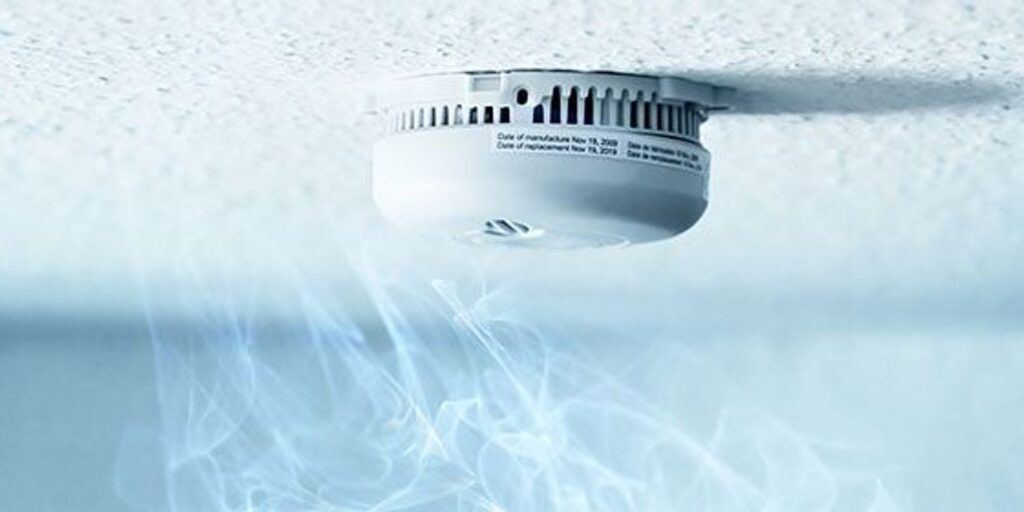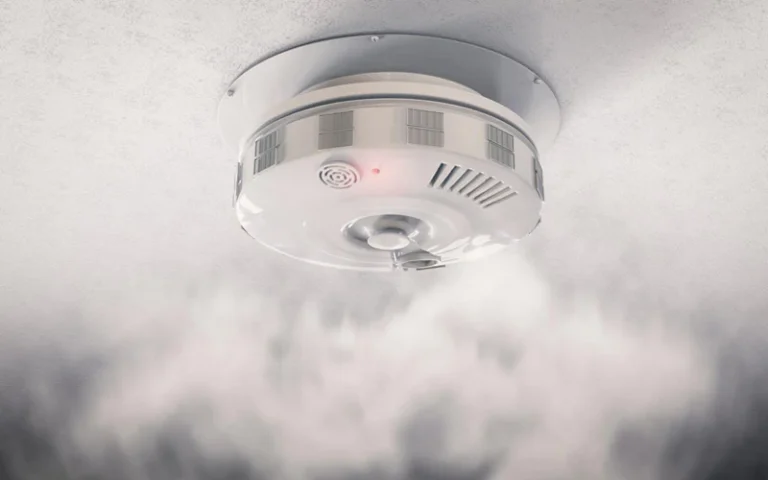Yes, The presence of steam, particularly dense steam generated from activities like hot showers or boiling water, can potentially set off certain types of smoke alarms. Steam particles may be misinterpreted by the detectors, leading to false alarms.
Furthermore, it’s important to understand that this sensitivity to steam is a common characteristic of some smoke detectors and doesn’t necessarily indicate a malfunction. Strategies such as proper ventilation and careful detector placement can help mitigate false alarms triggered by steam.
What are the two common types of smoke detectors?
There are two common types of fire alarms: ionization detectors and photoelectric detectors.
- Ionization Detectors:
- These are budget-friendly.
- They have two plates with a bit of safe radioactive stuff. This stuff makes the air between the plates have a steady flow of ions.
- When smoke gets in, it messes up the ion flow, and the alarm goes off.
- Photoelectric Detectors:
- These use a light source aimed into a chamber. The light reflects off the smoke and hits a sensor, making the alarm go off.
Steam vs. Smoke

| Characteristic | Steam | Smoke |
| Composition | Water vapor | Particulate matter, gases |
| Appearance | Transparent, white | Opaque, varying colors |
| Formation | Result of boiling water | Produced by combustion |
| Temperature | Hot | Can be hot or cool |
| State | Gaseous | Consists of tiny particles |
| Odor | Odorless | Often has a distinct smell |
| Visibility | Generally clear | Reduces visibility |
| Health Impact | Generally harmless | Can be harmful, depending on content |
| Applications | Used in power generation, cooking, etc. | Sign of incomplete combustion, can be used for smoking food |
How Smoke Alarms Work
Smoke alarms operate on the principle of detecting certain byproducts of combustion, signaling potential fire. There are primarily two types of smoke alarms commonly used: ionization smoke alarms and photoelectric smoke alarms.
- Ionization Smoke Alarms:
- Ionization Chamber: These alarms contain a small amount of radioactive material (americium-241) within an ionization chamber.
- Ionization Process: The radioactive material ionizes the air in the chamber, creating a small electric current.
- Smoke Detection: When it enters the chamber, it disrupts the ionization process, causing a drop in the electric current.
- Alarm Activation: The decrease in current triggers the alarm, alerting occupants to the presence of it.
- Photoelectric Smoke Alarms:
- Light Source and Photocell: Photoelectric alarms use a light source (usually an LED) and a photocell that are positioned at an angle to each other.
- Smoke Detection: In the absence of it, the light beam travels uninterrupted from the light source to the photocell.
- Scattering of Light: When particles enter the chamber, they scatter the light, causing it to be detected by the photocell.
- Alarm Activation: The detection of scattered light triggers the alarm, indicating the potential presence of it.
Key Points:
- Sensitivity to Particles: Both types of alarms are sensitive to airborne particles, with ionization alarms being more responsive to smaller particles produced by fast-burning fires, and photoelectric alarms being more sensitive to larger particles generated by slow, smoldering fires.
- Dual Sensor Alarms: Some modern ones use a combination of ionization and photoelectric technologies, providing a broader spectrum of fire detection.
- Power Source: They are typically powered by batteries, hardwired into the electrical system of a building, or a combination of both. Regular testing and maintenance are crucial to ensure proper functionality.
- Interconnectivity: In many installations, they are interconnected, so if one alarm detects smoke, all alarms in the network will sound simultaneously, ensuring a prompt response from occupants.
Regulatory Standards and Guidelines
Regulatory standards and guidelines play a crucial role in ensuring the effectiveness and reliability of smoke alarms. These standards are typically established by national and international organizations and are aimed at promoting uniformity, safety, and performance consistency across different brands and models.
Here is an overview of some key regulatory standards and guidelines related to smoke alarms:
- UL (Underwriters Laboratories) Standards:
- UL 217: This standard covers single and multiple-station smoke alarms, specifying requirements for construction, performance, and testing.
- UL 268: Addresses the standards for smoke detectors for fire alarm systems, including both photoelectric and ionization technologies.
- NFPA (National Fire Protection Association) Standards:
- NFPA 72: The National Fire Alarm and Signaling Code provides guidelines for the installation, maintenance, testing, and use of fire detection and alarm systems, including smoke alarms.
- Building Codes:
- International Building Code (IBC): The IBC provides guidelines for the construction and maintenance of buildings. It often includes requirements for the installation of smoke alarms in residential and commercial structures.
- International Residential Code (IRC): Specifically focuses on standards for residential construction, including provisions for the placement and types of smoke alarms in homes.
- European Standards (EN):
- EN 14604: This European standard outlines the requirements for smoke alarm devices used in residential properties. It covers aspects such as performance, marking, and user instructions.
- Consumer Product Safety Commission (CPSC):
- 16 CFR Part 1220: The CPSC sets federal safety standards for residential smoke alarms sold in the United States, including requirements for performance, reliability, and information provided to consumers.
- ASTM International Standards:
- ASTM E3005: Standard Practice for Obtaining Exposed Panels from Cigarette Smoke Detectors for Testing in Accordance with UL 217.
- ISO (International Organization for Standardization):
- ISO 7240-7: Specifies requirements, test methods, and performance criteria for point-type smoke detectors using scattered light, transmitted light, or ionization.
- Local and State Regulations:
- Many local and state authorities adopt specific regulations and codes that may impose additional requirements for the installation and maintenance of smoke alarms based on regional considerations.
Mitigation Strategies for Smoke Detector Challenges

- Regular Battery Maintenance:
- Conduct routine checks on batteries every six months.
- Replace depleted batteries promptly to prevent persistent chirping and ensure reliable functionality.
- Frequent Detector Cleaning:
- Regularly clean detectors to remove grime and dust.
- Follow manufacturer-recommended cleaning procedures to maintain sensor effectiveness.
- Insect Prevention Measures:
- Periodically inspect and clean detectors to deter insect intrusions.
- Seal detector openings to prevent insects from disrupting sensor operations.
- Fireplace Safety Precautions:
- Install detectors strategically to minimize false alarms from fireplace incidents.
- Make sure proper ventilation to prevent backdrafts and escape of errant smoke.
- Kitchen Caution:
- Exercise caution during cooking to avoid triggering alarms with excessive smoke.
- Use exhaust fans and cover pots and pans to contain smoke within acceptable levels.
- Understanding Steam Sensitivity:
- Recognize that steam may occasionally trigger alarms without indicating a malfunction.
- Ensure proper ventilation in steam-prone areas to disperse steam effectively.
- Humidity Control:
- Ventilate high-humidity environments adequately.
- Consider alternative detector types less impacted by humidity.
- Routine Maintenance Practices:
- Adhere to regular maintenance schedules and testing protocols.
- Test detectors periodically to ensure proper functioning.
- Construction Protection Measures:
- Shield detectors during construction or renovation projects to prevent dust infiltration.
- Ensure detectors are adequately protected from construction-related debris.
- Addressing Electrical Irregularities:
- Promptly address electrical issues with the assistance of qualified professionals.
- Make sure stable power sources to prevent disruptions to detector functioning.
- Strategic Detector Placement:
- Install detectors away from direct steam sources.
- Consider dual-sensor detectors for comprehensive fire detection in various scenarios.
- Upgrading to Advanced Technology:
- Consider modern detectors with advanced features, such as reduced sensitivity to steam.
- Upgrade to dual-sensor detectors for improved accuracy in fire detection.
- Ventilation Management:
- Prioritize effective ventilation in steam-prone areas to disperse steam and minimize its impact on detectors.
- Also, make sure fans are not directing air currents toward detectors.
- Temporary Shielding in Specific Areas:
- Use temporary shields in areas prone to false alarms, such as the bathroom during steam-producing activities.
- Remove shields promptly after the activities to reinstate detector vigilance.
FAQ’s
Can steam make smoke alarms go off?
Yes, steam can trigger smoke alarms as they are sensitive to foreign objects, including vapor and steam. This sensitivity can lead to false alarms, especially during activities like cooking.
Can a heat alarm be set off by steam?
No, heat detectors are not affected by steam or smoke. They are designed to detect temperature changes, ignoring influences like steam or normal cooking temperatures.
Can smoke detectors be set off by steam or aerosols?
Yes, some smoke detectors are extremely sensitive, and steam from showers, smoke from burning food, or aerosol sprays can set them off. Proper measures should be taken to avoid false alarm activation.
Can steam cause ionization smoke detector false alarms?
Yes, steam can appear as deceptive phenomena to ionization smoke detectors, causing nuisance alarms.
Why doesn’t steam set off fire alarms?
Vapour or steam is not smoke, and it’s not hot, making it unlikely to set off a smoke alarm. However, attention should be paid to chemicals in the air, and a kitchen smoke detector is recommended.
Can heat make a smoke alarm go off?
Certain fire alarms sensitive to heat will go off if they sense a change in temperature.
What can cause false smoke alarms?
Causes include cooking fumes, steam, smoking, aerosol sprays, hot work/dusty work, accidental damage, and testing/maintenance.
Do smoke detectors detect vape?
Yes, smoke detectors can be triggered by vapor from e-cigarettes and vaporizers if blown directly into the detector.
Why is my smoke detector going off without smoke?
Malfunctioning sensors or components, the age of the smoke detector, and excessive sensitivity can cause smoke detectors to go off without the presence of smoke. Regular replacement is recommended.
Final Words
In conclusion, steam can indeed set off a smoke alarm, particularly in detectors sensitive to the presence of particles in the air. The occurrence of false alarms due to steam is a known phenomenon, and it is essential for users to recognize that this sensitivity does not necessarily indicate a malfunction in the alarm system.
Moreover, understanding the factors that contribute to false alarms, such as proper ventilation, strategic detector placement, and the type of detector technology used, is crucial for maintaining the effectiveness of smoke alarm systems.
Furthermore, users can implement practical measures to reduce the likelihood of steam-triggered false alarms, ensuring that their smoke detectors remain reliable in detecting actual fire hazards while minimizing inconvenient disruptions

